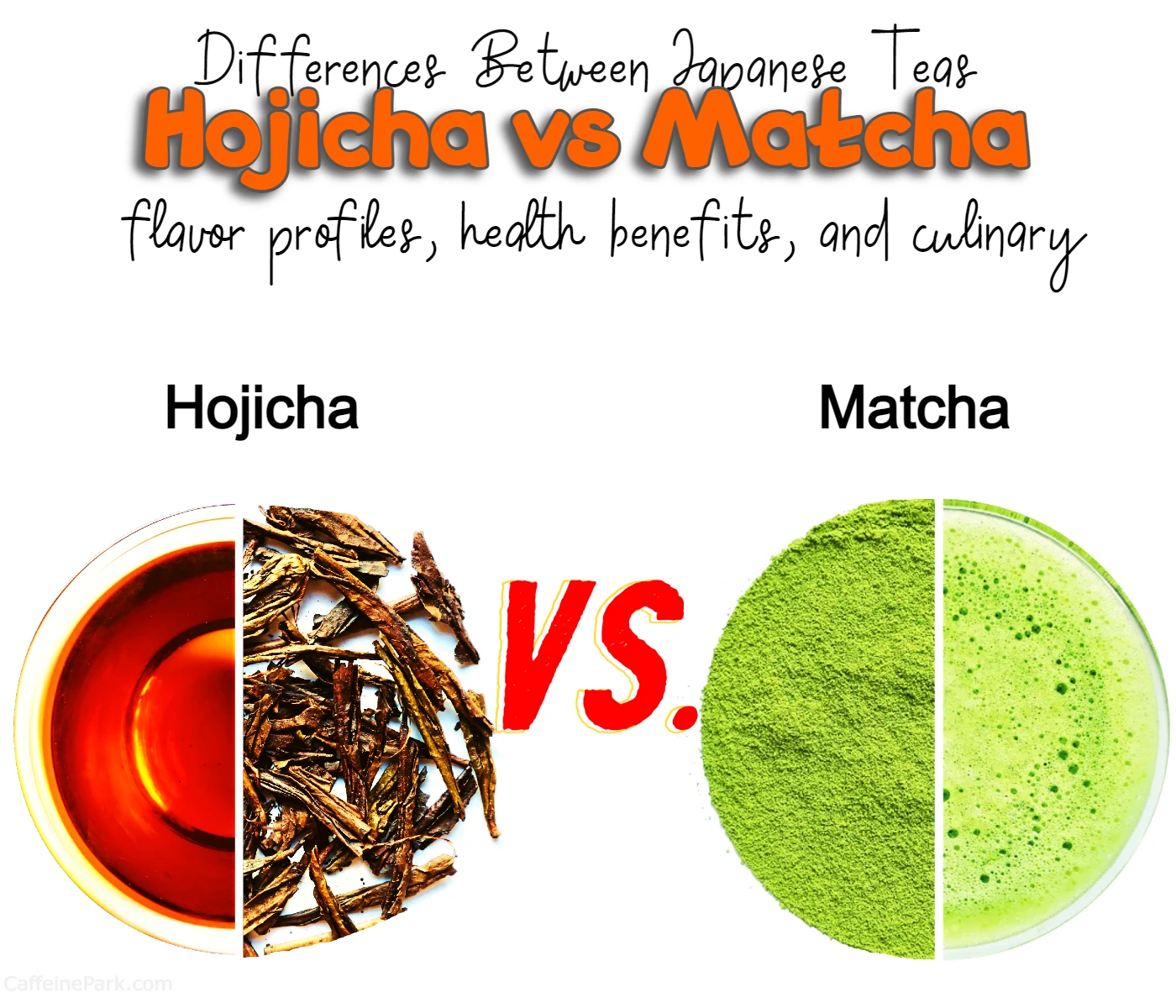
Hey there, tea enthusiasts! If you’re a fan of Japanese tea, you’ve probably heard of matcha and Hojicha. These two teas have gained immense popularity around the world and are enjoyed for their unique taste and health benefits. But what’s the difference between Matcha and Hojicha, you may ask? Well, that’s exactly what we’re here to talk about!
In this blog, we’ll take a deep dive into the differences between Hojicha and Matcha. We’ll explore the flavor profiles, caffeine content, health benefits, and even culinary uses of these two teas. By the end of this article, you’ll have a better understanding of which tea is the right fit for you.
So, whether you’re a matcha lover, a Hojicha fan, or just looking to try something new, you won’t want to miss this blog. Sit back, relax, and get ready to learn all about the delicious world of Japanese tea. And don’t forget to read to the end to get the full scoop on Hojicha vs Matcha. Let’s get started!
Here’s a table highlighting the key differences between Hojicha and Matcha:
| Aspect | Hojicha | Matcha |
|---|---|---|
| Flavor Profile | Toasty, nutty, with a hint of smokiness | Vibrant, balanced, slightly grassy |
| Caffeine Content | Lower caffeine content compared to other green teas | Moderate caffeine content |
| Preparation | Simple brewing process | Ceremonial preparation involving whisking |
| Health Benefits | Potential digestive benefits, lower caffeine content | Potential antioxidant benefits, gentle energy boost |
| Price | Generally more affordable | Can be pricier, varies by grade |
| Availability | Widely accessible | Readily available, but varies by quality |
| Culinary Uses | Infused in baked goods, ice creams, and more | Used in traditional Japanese sweets, lattes, smoothies, and more |
| Cultural Significance | Informal and laid-back | Associated with formal tea ceremonies and Zen Buddhism |
| Aesthetic Appeal | Warm amber color | Vibrant green color |
Differences between Matcha and Hojicha
Hojicha: Embracing Simplicity and Subtle Roasted Delights
Let’s begin our exploration with Hojicha, a roasted green tea that showcases simplicity in its preparation and a charming flavor profile. Hojicha is renowned for its smooth and toasty taste, making it a beloved choice for those seeking a mellow and comforting tea experience.
Flavor Profile:
Hojicha’s flavor profile is a delightful blend of earthy, nutty, and slightly smoky notes. The tea leaves used for Hojicha are roasted, which gives it a distinctive amber hue and imparts a unique aroma. This gentle roasting process diminishes the astringency found in other green teas, resulting in a smoother and more approachable taste. The roasted flavors harmonize beautifully with the natural sweetness of the tea, offering a comforting and well-rounded sip.
Preparation:
Preparing a cup of Hojicha is a breeze, making it an ideal choice for tea enthusiasts who appreciate simplicity. Here’s a step-by-step guide to brewing this delectable tea:
- Start by heating water to approximately 90°C (194°F). This slightly lower temperature compared to other green teas helps bring out the best flavors of Hojicha without risking any bitterness.
- Measure around 2 grams (1 teaspoon) of Hojicha leaves per 200 ml (6.7 oz) of water, adjusting the amount based on personal preference.
- Place the Hojicha leaves in a teapot or teacup.
- Pour the heated water over the leaves and let them steep for about 30 seconds to 1 minute. You can adjust the steeping time according to your desired strength.
- Strain the liquid into your favorite teacup, sit back, and savor the comforting flavors of Hojicha.
Hojicha is also versatile when it comes to cold brew preparations. Simply add a generous amount of Hojicha leaves to cold water and let it infuse in the refrigerator for a few hours. The result is a refreshing and subtly sweet iced tea, perfect for hot summer days!
Health Benefits:
While sipping on a delicious cup of Hojicha, you can also reap several health benefits. Here are a few reasons why Hojicha has gained popularity among health-conscious tea drinkers:
- Lower Caffeine Content: If you’re looking for a tea with a lower caffeine content, Hojicha is an excellent choice. The roasting process reduces caffeine levels, making it a suitable option for those who are more sensitive to stimulants.
- Rich in Antioxidants: Hojicha, like other green teas, contains a plethora of antioxidants that can help protect your body against harmful free radicals. Antioxidants are known for their potential to support overall well-being and promote a healthy immune system.
- Gentle on Digestion: The roasting process of Hojicha lowers its tannin levels, which are responsible for the astringent and sometimes harsh qualities found in other teas. As a result, Hojicha is gentle on the stomach, making it a soothing choice for those with sensitive digestion.
- Hydration and Calorie-Free: Good news for those aiming to stay hydrated without consuming excessive calories! Hojicha is an excellent option as it contains minimal to no calories, making it a guilt-free and refreshing beverage to enjoy throughout the day.
Now that we’ve familiarized ourselves with the delightful attributes of Hojicha let’s move on to its vibrant counterpart – Matcha!
Matcha: The Artful Elixir of Vibrancy and Tranquility
As we delve into the realm of Matcha, we encounter a tea that is revered for its vibrant green hue, ceremonial preparation, and unique flavor profile. Matcha is not just a tea; it is an experience that embodies tradition, craftsmanship, and the quest for inner tranquility.
Flavor Profile:
Matcha’s flavor is distinct, vibrant, and slightly grassy, offering a harmonious balance of umami and sweetness. Its vibrant green color is a result of the shaded growth of the tea leaves, which promotes the production of chlorophyll and other compounds responsible for Matcha’s unique taste. When prepared properly, Matcha provides a smooth, velvety mouthfeel that leaves a lingering, pleasant aftertaste.
Preparation:
The traditional preparation of Matcha is steeped in ritual and precision, creating a serene moment to appreciate the artistry behind this tea. Here’s a guide to whisking your own bowl of Matcha:
- Begin by sifting 1 to 2 teaspoons of Matcha into a dry bowl using a fine-mesh sieve. This helps remove any lumps and ensures a smooth consistency.
- Heat water to about 70°C to 80°C (160°F to 175°F), as boiling water can scorch the delicate Matcha and result in a bitter taste.
- Pour a small amount of hot water (about 30 ml or 1 oz) into the bowl of Matcha and use a bamboo Matcha whisk, or chasen, to gently whisk the tea in a “W” motion until a smooth, frothy layer forms on the surface.
- Gradually add the remaining hot water while continuing to whisk in a brisk and steady motion. Aim for a total of 60 to 70 ml (2 to 2.4 oz) of water, but feel free to adjust the amount to suit your taste preferences.
- Once the Matcha is thoroughly whisked and the tea has a consistent, frothy texture, it is ready to be savored. Enjoy the serene and vibrant experience of drinking Matcha!
For those who prefer a modern twist, Matcha can also be incorporated into various culinary creations, such as lattes, smoothies, and desserts. Its vibrant color and distinct flavor add a unique touch to a wide range of recipes.
Health Benefits:
Matcha’s reputation as a healthy beverage is well-deserved, as it offers a host of potential health benefits. Here are a few reasons why Matcha has gained a dedicated following among wellness enthusiasts:
- Antioxidant Powerhouse: Matcha boasts a high concentration of antioxidants, including the powerful catechin called epigallocatechin gallate (EGCG). These antioxidants can help combat oxidative stress, support cellular health, and contribute to overall well-being.
- Enhanced Calmness and Focus: Matcha contains an amino acid called L-theanine, which is known to promote a sense of relaxation and mental clarity. The combination of L-theanine and a moderate amount of caffeine in Matcha creates a state of calm alertness, offering a more balanced and sustained energy boost compared to other caffeinated beverages.
- Metabolism Boost: Some studies suggest that Matcha may have a positive impact on metabolism and fat oxidation, making it a potential ally for those looking to maintain a healthy weight. However, it’s important to note that individual results may vary, and a balanced lifestyle is key to achieving overall wellness.
- Detoxification Support: The shade-growing process of Matcha contributes to its higher chlorophyll content. Chlorophyll is believed to aid in detoxification by assisting the body in eliminating toxins and promoting healthy digestion.
With its vibrant hue and a myriad of potential health benefits, Matcha has become a beloved beverage for those seeking a mindful and nourishing tea experience.
Nutritional Comparison: Hojicha vs. Matcha
When it comes to the nutritional content of Hojicha and Matcha, there are some differences worth exploring. While both teas offer potential health benefits, let’s take a closer look at their nutritional profiles.
In terms of calories, Hojicha is virtually calorie-free. It contains minimal to no calories, making it an excellent choice for those watching their calorie intake or looking for a hydrating and refreshing beverage without adding extra calories to their diet. Hojicha is also low in carbohydrates, fats, and proteins, making it a light and guilt-free option.
On the other hand, Matcha offers a unique nutritional profile due to its preparation process and consumption of whole tea leaves. Matcha is known for its high concentration of antioxidants, which are beneficial compounds that help protect the body from oxidative stress and inflammation. One of the key antioxidants found in Matcha is called epigallocatechin gallate (EGCG), which has been linked to potential health benefits such as improved heart health, enhanced brain function, and increased fat oxidation.
Matcha is also a source of vitamins and minerals. It contains vitamins A, C, and E, as well as trace minerals like potassium, calcium, and iron. However, it’s important to note that the amounts of these nutrients may vary depending on the specific brand and grade of Matcha.
Flavor Profile
One of the most significant differences between Matcha and Hojicha is their flavor profiles. Matcha has a bold, complex flavor that is both sweet and bitter. Its umami taste is often described as grassy, vegetal, or even seaweed-like. In contrast, Hojicha has a nutty, toasty flavor that is mild and smooth. Its roasted aroma adds a layer of depth to its flavor profile, making it a soothing and comforting tea to drink.
Caffeine Content
Another difference between matcha and Hojicha is their caffeine content. Matcha has a high caffeine content due to the fact that it is made from whole tea leaves. One cup of matcha contains approximately 68 milligrams of caffeine, which is roughly equivalent to a cup of coffee. In contrast, Hojicha has a lower caffeine content because the roasting process reduces the caffeine levels in the tea. One cup of Hojicha contains only about 7.7 milligrams of caffeine, which is about the same as a cup of decaffeinated tea.
Preparation Method
The preparation method for Matcha and Hojicha is also quite different. Matcha is traditionally prepared using a bamboo whisk and a bowl. The powder is sifted into the bowl, hot water is added, and then the mixture is whisked vigorously until it becomes frothy. In contrast, Hojicha can be prepared using a variety of methods, including a teapot, a tea strainer, or even a French press. The leaves are steeped in hot water for a few minutes, and then the tea is strained and served.
Health Benefits
Both Matcha and Hojicha are packed with health benefits, but they differ slightly in terms of their nutritional profiles. Matcha is rich in antioxidants, including EGCG, which is a potent catechin that has been shown to have anti-inflammatory and cancer-fighting properties. Matcha also contains a unique amino acid called L-theanine, which has been shown to reduce stress and improve mental clarity. Hojicha, on the other hand, is low in caffeine and high in catechins, which are another type of antioxidant. Catechins have been linked to a reduced risk of heart disease, stroke, and some types of cancer.
Culinary Uses
Matcha is often used in cooking and baking because of its bright green color and unique flavor. It can be used to make everything from lattes and smoothies to cakes and cookies. Hojicha, on the other hand, is not typically used in cooking, but
it is sometimes used as a flavoring agent in desserts or as a topping for ice cream or yogurt. Hojicha can also be enjoyed in its pure form as a warm or cold beverage.
The Price Point and Availability
When it comes to purchasing tea, price, and availability are important factors to consider. Let’s take a look at how Hojicha and Matcha compare in terms of cost and accessibility.
Hojicha, being a roasted green tea, is generally more affordable compared to Matcha. The roasting process used in its production allows for the use of lower-grade tea leaves, which results in a lower price point. Additionally, Hojicha is widely available in tea shops, grocery stores, and online retailers, making it easily accessible to tea enthusiasts around the world. Whether you prefer loose-leaf Hojicha or convenient tea bags, you can typically find Hojicha at an affordable price.
On the other hand, Matcha, with its ceremonial-grade status and meticulous production process, tends to be more expensive. The shade-growing technique, hand-picking of young leaves, and stone grinding contribute to the higher cost of Matcha. Matcha is often categorized into different grades based on quality, with ceremonial-grade Matcha being the highest quality and therefore the most expensive. However, there are also culinary-grade Matcha options available at a lower price point, which are suitable for cooking and blending purposes.
While Matcha may be pricier, it offers a unique and luxurious tea experience that many tea enthusiasts find worth the investment. Its vibrant green color, rich flavor, and potential health benefits make it a sought-after tea. Matcha can be purchased from specialized tea shops, online retailers, and even some grocery stores. The availability of Matcha has significantly increased in recent years, catering to the growing demand for this beloved tea.
Culinary Delights and Food Pairings
Tea is not only a beverage but also a versatile ingredient that can be incorporated into various culinary creations. Both Hojicha and Matcha lend their unique flavors and vibrant colors to a wide range of dishes. Let’s explore how these teas can elevate your culinary adventures!
Hojicha, with its toasty and nutty flavor profile, adds a delightful twist to both sweet and savory recipes. The roasted notes of Hojicha complement baked goods, desserts, and even savory dishes. Here are a few examples of how you can incorporate Hojicha into your culinary repertoire:
- Hojicha Latte: Create a cozy and comforting beverage by infusing Hojicha leaves in hot milk. Add a touch of sweetness with honey or your preferred sweetener for a creamy and aromatic Hojicha latte.
- Hojicha Ice Cream: Infuse cream with Hojicha leaves to infuse the tea’s rich flavors into a homemade ice cream base. The result is a creamy and slightly smoky ice cream that will delight your taste buds.
- Hojicha-Infused Baked Goods: Add ground Hojicha leaves to cookie dough, cake batter, or bread recipes to impart a unique and nutty flavor. Hojicha cookies, Hojicha pound cake, or even Hojicha-infused bread can be a delightful treat for tea lovers.
Matcha, with its vibrant green color and distinct taste, is particularly popular in desserts, beverages, and traditional Japanese sweets. The rich umami and slight bitterness of Matcha lend themselves well to a variety of culinary creations. Here are a few ways to incorporate Matcha into your culinary endeavors:
- Matcha Latte: Whisk Matcha powder with hot milk and a touch of sweetener to create a creamy and frothy Matcha latte. The vibrant green color and unique flavor make it an Instagram-worthy beverage.
- Matcha Smoothies: Add a spoonful of Matcha powder to your favorite smoothie recipe for an antioxidant-rich boost. Matcha pairs well with fruits like bananas, berries, and mangoes, offering a refreshing and energizing drink.
- Matcha Desserts: From Matcha-flavored cakes and cupcakes to Matcha-infused chocolates and truffles, the possibilities are endless. The earthy and vibrant taste of Matcha adds a sophisticated touch to desserts and satisfies the sweet tooth of tea enthusiasts.
When it comes to food pairings, Hojicha and Matcha can complement a variety of flavors. Hojicha’s toasty and nutty notes make it a delightful accompaniment to dishes with earthy flavors, such as roasted vegetables, nuts, and caramelized flavors. It can also be enjoyed alongside light snacks, such as buttery cookies or biscotti.
Matcha, with its vibrant and complex flavor profile, pairs well with delicate and subtle flavors. It harmonizes beautifully with sweet treats like white chocolate, vanilla, and citrus-based desserts. Traditional Japanese sweets, such as mochi and wagashi, often feature Matcha as a key ingredient.
The Cultural Significance and Rituals: Hojicha vs. Matcha:
Tea holds a special place in Japanese culture, and both Hojicha and Matcha have their own significance and rituals that add depth to the tea-drinking experience. Let’s dive into the cultural aspects of these teas and explore the traditions associated with Hojicha and Matcha.
Hojicha, with its roots in Kyoto, Japan, has a more informal and laid-back vibe compared to Matcha. It is often enjoyed as a casual tea, perfect for everyday relaxation. Hojicha is commonly served in teahouses, restaurants, and even at home. Its comforting and approachable nature makes it a favorite choice for tea enthusiasts seeking a moment of tranquility.
Matcha, on the other hand, is deeply intertwined with Japanese tea ceremonies and Zen Buddhism. The preparation and consumption of Matcha are considered art forms that embody mindfulness, respect, and harmony. Matcha ceremonies, known as Chanoyu or Sado, involve meticulous rituals and attention to detail. These ceremonies often take place in specially designed tearooms, where guests can witness the beauty and grace of Matcha preparation.
During a Matcha ceremony, a host carefully prepares and serves Matcha to guests, following a specific set of gestures and procedures. The ceremonial-grade Matcha used in these rituals is of the highest quality, known for its vibrant color, smooth texture, and exquisite taste. The act of sipping Matcha in a traditional tea ceremony fosters a sense of tranquility, focus, and connection to the present moment.
While Matcha ceremonies are more formal and require specialized knowledge and training, they offer a profound and immersive experience for participants. They provide a glimpse into the rich traditions and philosophies that have shaped Japanese tea culture.
In everyday life, Matcha is also enjoyed outside of formal ceremonies. It is served in teahouses, cafes, and even in modern settings like Matcha bars. Matcha has gained global popularity, and its cultural significance has transcended borders, making it a cherished beverage worldwide.
Final Thoughts: Choosing Between Hojicha and Matcha
As we conclude our exploration of Hojicha and Matcha, it’s clear that both teas have their own captivating characteristics, flavors, and traditions. The choice between Hojicha and Matcha ultimately comes down to personal preference and the kind of tea experience you seek.
Hojicha, with its toasty and nutty flavors, offers a comforting and approachable tea experience. Its lower caffeine content, gentle taste, and availability make it a versatile and popular choice. Hojicha’s affordability and suitability for both hot and cold brewing make it an accessible and satisfying beverage for tea enthusiasts of all levels.
Matcha, on the other hand, presents a vibrant and ceremonial tea experience. Its unique flavor profile, vibrant green color, and potential health benefits have garnered a dedicated following. The rituals associated with Matcha preparation and its connection to Japanese tea culture add depth and mindfulness to the tea-drinking experience. Matcha’s versatility in both traditional ceremonies and culinary creations allows for endless possibilities.
Whether you prefer the comforting and toasty notes of Hojicha or the vibrant and serene experience of Matcha, both teas have their own allure and offer a delightful escape into the world of tea. So, dear tea enthusiasts, embrace the journey, sip mindfully, and let the flavors of Hojicha and Matcha transport you to a place of tranquility and delight. Cheers to the wonders of tea!
Alternative to Hojicha and Matcha
If you’re looking for alternatives to Hojicha and Matcha, here are a few options:
- Sencha: Sencha is a type of Japanese green tea that is widely available and has a grassy, vegetal flavor. It is often served hot, but can also be enjoyed iced.
- Genmaicha: Genmaicha is a blend of green tea and roasted brown rice that has a nutty flavor and aroma. It is also a Japanese tea and can be served hot or cold.
- Oolong: Oolong is a type of partially oxidized tea that can vary in flavor from light and floral to dark and smoky. It is popular in China and Taiwan and can be served hot or cold.
- Rooibos: Rooibos is a South African herbal tea that is naturally caffeine-free and has a sweet, nutty flavor. It can be enjoyed hot or iced and is often used as a base for flavored teas.
- Herbal blends: There are countless herbal teas available that can be enjoyed hot or cold, depending on your preference. Some popular options include chamomile, peppermint, and ginger.
These are just a few options to consider, but there are many different types of tea and herbal blends available that you may enjoy.
FAQs
Hojicha and matcha are two distinct types of Japanese green tea with different flavor profiles, caffeine levels, and health benefits. Matcha is made from young tea leaves that are ground into a fine powder and have a bold and complex flavor. Hojicha, on the other hand, is made from older tea leaves that are roasted to bring out a mellow and toasty taste.
Both Hojicha and Matcha offer a range of health benefits, but they differ in terms of their nutrient profiles. Matcha contains more antioxidants, particularly catechins, than Hojicha, which makes it a potent anti-inflammatory and anti-cancer agent. Hojicha, on the other hand, is low in caffeine and high in the amino acid theanine, which promotes relaxation and reduces stress.
Yes, both Hojicha and Matcha can be used in cooking and baking. Matcha is often used in desserts, such as cakes, cookies, and ice cream, while Hojicha is used in savory dishes, such as soups, stews, and marinades. You can also use Hojicha and Matcha in smoothies, lattes, and other beverages.
Yes, matcha is generally more expensive than Hojicha due to its labor-intensive production process. The highest quality matcha is made from the youngest and most tender tea leaves, which are hand-picked and carefully processed. As a result, high-grade matcha can cost anywhere from $20 to $40 per ounce. Hojicha, on the other hand, is typically less expensive because it is made from older tea leaves that are roasted to bring out their flavor.
Hojicha and matcha are widely available in specialty tea shops and online. However, matcha is more commonly found in upscale cafes and restaurants, where it is often used in lattes and other beverages. Hojicha, on the other hand, is less commonly found in cafes and is more commonly enjoyed at home or in traditional Japanese tea ceremonies.
Read More:
Source:





